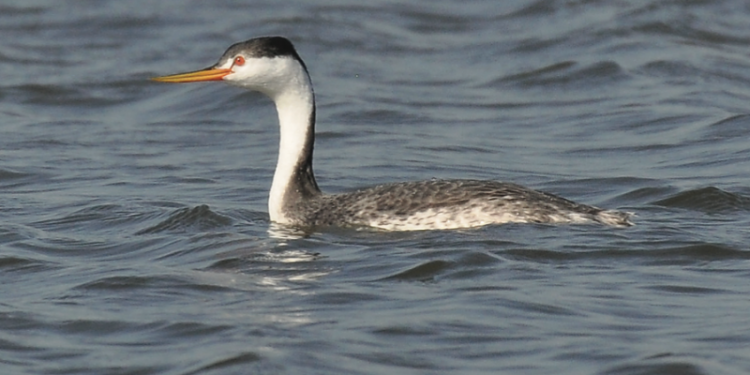As Look, in the sky! It’s a bird … it’s a plane … it’s Clark Kent, er, a Clark’s grebe!
Actually, a Clark’s grebe IS a bird, and it would most likely be in water, rather than in the air, as grebes are seldom seen in flight. Grebes are aquatic diving birds and are very good at maneuvering underwater. They do this to hunt for food and to avoid predation.
Their look and behavior have fascinated me since I was a kid. Clark’s and western grebes are closely related and are very similar in appearance. In fact, until the 1980s, Clark’s grebes were thought to be a light morph of western grebes. As a young birder, I had seen photos of both species in books, and knew that I wanted to see them with my own eyes.
Then, around 1987, I saw a pair of western grebes at Hagerman National Wildlife Refuge at Lake Texoma. It was a rare sighting for sure, and, when I reported it to refuge staff, they doubted me. I guess it was because of my young age that they didn’t believe me, but when I returned a week later, many other people had seen them, and it was all the rage. Sweet vindication! And I saw them first. However, I didn’t see a western grebe again until October of this year when I traveled to Hackberry Flat Wildlife Management Area to observe one. It was definitely worth the drive.
And, when I recently learned there was a Clark’s grebe at Lake Hefner in Oklahoma City, an even rarer visitor to the state than the western, and a species I had never seen before, I made the trip up there Oct. 7. It took a little while for me to locate it, but once I did, it too was well worth the drive, and the search. I couldn’t get close enough for great photos, but I was able to get some decent pics, and observe the bird and its behavior for a few hours.
It was quite successful at catching fish, and I also noticed when it rested or slept, it did so in the company of other grebes, such as horned and eared. Pretty smart, if you ask me. Now, I don’t know if the bird is still there, but it was sighted Sunday at Lake Hefner, around Prairie Dog Point. The bird has been there for a few weeks, and, was once hanging out with a western grebe, but that bird left a little more than two weeks ago.
However, a western grebe was later sighted at nearby Lake Overholser and is possibly the bird from Lake Hefner. My advice, if you’re interested, is to sign up for eBird’s rare bird alerts for Oklahoma. Checking it daily is a good way to know when and where rare birds are being seen. Grebes, like loons, are specialized for diving in water. Their feet are located far back on their bodies. While they are awkward on land because of the feet location, they are brilliant under the water’s surface, like fish-seeking torpedoes. They have dense, waterproof plumage and lobed toes, which aide the process.
The dance
Clark’s grebes, and westerns too, are known for their spectacular ritualized dance. This dance occurs between a male and female for reassurance of their commitment to each other. It is smooth and elegant, and, at the climax of the dance, the birds stretch out their necks and run across the surface of the water together for quite some distance, then dive into the water. It really is quite spectacular. I’ve seen it dozens of times on film, but I’ve never witnessed it with my own eyes. It’s definitely on my list of things to see before I die, however. According to eBird, Clark’s grebes have been spotted at least two times in Comanche County, presumably at Lake Lawtonka.
Appearance
Large, slender black and white grebe with yellow-orange bill which is long and thin (see photo). Upper mandible is straight, while the lower mandible is upturned. It sort of makes the bill appear to curve upward. To me, the birds look like they’re smiling. In winter, the black coloring on the backs of these birds is not as dark as it is during the breeding season (see photo). The way I differentiate between a Clark’s and a western is, the red eyes of the Clark’s grebe are surrounded by white on the face, while the black cap of a western extends below the eyes. Also, Clark’s grebes have bills which are more orange than the west- ern’s yellowish bill.
Range
Clark’s grebes are birds of the American West. Their common breeding areas are in Southern Colorado and Northern New Mexico, and an area where California, Nevada and Oregon meet. The uncommon breeding range includes most of the western states and up into the Dakotas. They winter along the West Coast, an area of southern New Mexico and West Texas, and sometimes along the Gulf Coast.
Food
Mostly fish. However, according to the Cornell Lab of Ornithology, they also eat salamanders, worms, grasshopper and other aquatic insects and larvae.
Habitat
Large freshwater lakes and marshes the edges of which have emergent vegetation such as reeds and rushes, according to the Cornell Lab. In winter, they can also be found along ocean shores and tidal bays.
Odds and ends
• According to the Cornell Lab, western and Clark’s grebes were considered the same species until 1985, when scientists discovered that the two species rarely interbreed, despite sometimes living on the same lake. They also make different calls and have substantial DNA differences.
• The Clark’s grebe was named after John Henry Clark, a 19th-century American surveyor, naturalist and collector.
Hodgepodge
As I mentioned before, a good way to know what’s going on in the state, bird-wise, is to sign up for alerts at eBird — https://ebird.org/alerts. There have been a lot of rare sightings so far this fall. Lots of rarities at Hef- ner, Carl Blackwell Lake near Stillwater and Lake Tenkiller near Vian, among others. This is an irruption year for many species of birds. Purple finches are being seen all over the state, so keep your eyes peeled.
I will continue to feature sparrows in the coming weeks, but I may feature other species once in a while, especially if their presence in the state is timely. Randy Mitchell is a freelance writer and photographer. He has been an avid birdwatcher, nature enthusiast and photographer for 40 years. Reach him at rnw@usa.com.
Want to reach a local audience and grow your business?
Our website is the perfect platform to connect with engaged readers in your local area.
Whether you're looking for banner ads, sponsored content, or custom promotions, we can tailor a package to meet your needs.
Contact us today to learn more about advertising opportunities!
CONTACT US NOW




